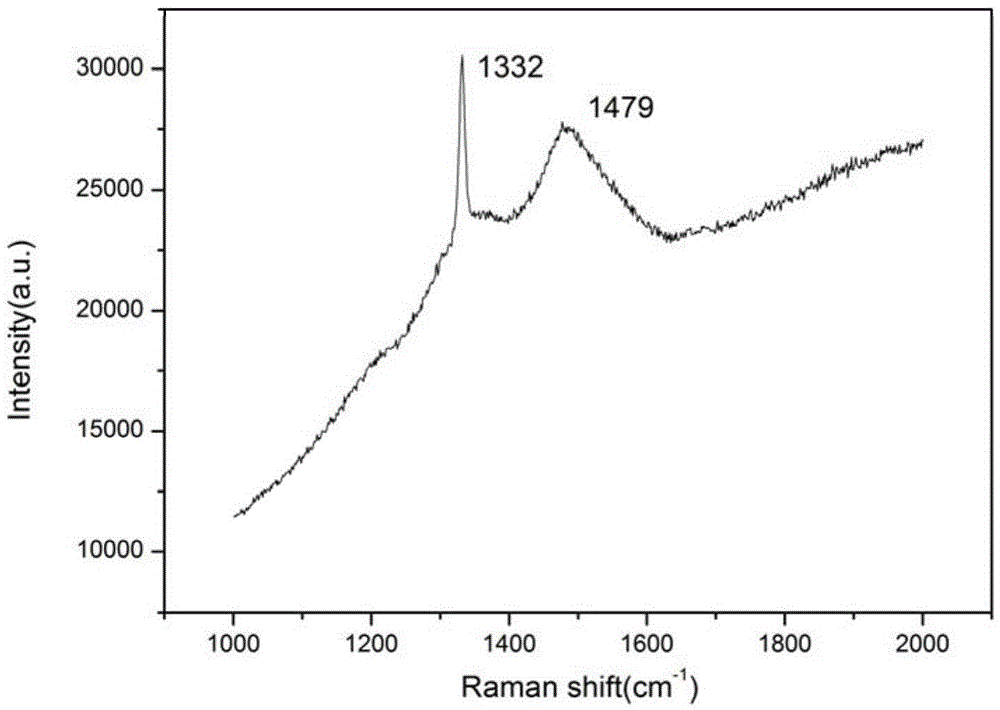Method for directly depositing diamond film on graphite substrate
A technology of diamond film and graphite substrate, which is applied in metal material coating process, gaseous chemical plating, coating, etc., can solve the problem of difficult to obtain high-quality diamond film, achieve stable bonding, good film bonding force, and high quality high effect
- Summary
- Abstract
- Description
- Claims
- Application Information
AI Technical Summary
Problems solved by technology
Method used
Image
Examples
Embodiment 1
[0020] (1) Grind the graphite sample with 1000-mesh metallographic sandpaper, put the polished graphite sample in acetone for ultrasonic vibration cleaning for 10 minutes, take out the sample and put it in alcohol for ultrasonic vibration cleaning for 10 minutes, take out the sample and put it in deionized water for ultrasonic vibration cleaning After 10 minutes, take it out and put it into the drying oven to dry.
[0021] (2) Put the cleaned graphite sample into the reactor, vacuumize the reaction chamber to reach the background true 1×10 -3 Above Pa. Afterwards, 100 sccm of hydrogen gas was introduced to adjust the internal air pressure during the reaction so that the air pressure in the reaction chamber reached 6kPa. The filament is heated to 2000°C, the substrate temperature is controlled at 800°C, and the thermally decomposed atomic hydrogen etches the surface of the graphite substrate for 20 minutes.
[0022] (3) Maintain the temperature of the filament at 2000°C, cont...
Embodiment 2
[0025] (1) Grind the graphite sample with 1000-mesh metallographic sandpaper, put the polished graphite sample in acetone for ultrasonic vibration cleaning for 10 minutes, take out the sample and put it in alcohol for ultrasonic vibration cleaning for 10 minutes, take out the sample and put it in deionized water for ultrasonic vibration cleaning After 10 minutes, take it out and put it into the drying oven to dry.
[0026] (2) Put the cleaned graphite sample into the reactor, vacuumize the reaction chamber to reach the background true 1×10 -3 Above Pa. Afterwards, 100 sccm of hydrogen gas was introduced, and the air pressure in the reaction chamber was adjusted so that the air pressure in the reaction chamber reached 6 kPa. The filament is heated to 2000°C, the substrate temperature is controlled at 800°C, and the thermally decomposed atomic hydrogen etches the surface of the graphite substrate for 20 minutes.
[0027] (3) Keep the temperature of the filament at 2000° C., co...
Embodiment 3
[0030] (1) Grind the graphite sample with 1000-mesh metallographic sandpaper, put the polished graphite sample in acetone for ultrasonic vibration cleaning for 20 minutes, take out the sample and put it in alcohol for ultrasonic vibration cleaning for 20 minutes, take out the sample and put it in deionized water for ultrasonic vibration cleaning After 20 minutes, take it out and put it into the drying oven to dry.
[0031] (2) Put the cleaned graphite sample into the reactor, vacuumize the reaction chamber to reach the background true 1×10 -3 Above Pa. Afterwards, 150 sccm of hydrogen gas was introduced to adjust the air pressure in the reaction chamber so that the air pressure in the reaction chamber reached 10 kPa. The filament is heated to 1800°C, the substrate temperature is controlled at 750°C, and the thermally decomposed atomic hydrogen etches the surface of the graphite substrate for 40 minutes.
[0032] (3) Keep the temperature of the filament at 1800° C., control t...
PUM
 Login to View More
Login to View More Abstract
Description
Claims
Application Information
 Login to View More
Login to View More - Generate Ideas
- Intellectual Property
- Life Sciences
- Materials
- Tech Scout
- Unparalleled Data Quality
- Higher Quality Content
- 60% Fewer Hallucinations
Browse by: Latest US Patents, China's latest patents, Technical Efficacy Thesaurus, Application Domain, Technology Topic, Popular Technical Reports.
© 2025 PatSnap. All rights reserved.Legal|Privacy policy|Modern Slavery Act Transparency Statement|Sitemap|About US| Contact US: help@patsnap.com



